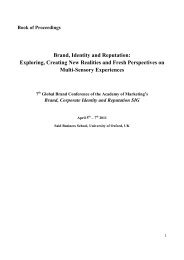Create successful ePaper yourself
Turn your PDF publications into a flip-book with our unique Google optimized e-Paper software.
CHAPTER 2<br />
LITERATURE REVIEW<br />
This chapter consists of information which related to the study such as the theory and<br />
method that had been used by the others in order to investigate the corrosion<br />
behavior of tool steel in tannic acids. This information is important because it will<br />
lead to this study applicability until complete. In this research, it also the best way to<br />
guide and face the problem encountered during the completion of this study.<br />
2.1 Definition of Tannins<br />
The term “tannins” is no longer strange in chemistry field. It is comes from the<br />
ancient Celtic word for oak which is a typical source of tannins for leather making<br />
(Bisanda et al., 2003). According to Khanbabaee and Van Ree (2001), the name<br />
“tannin” is derived from the French word „Tanin‟ which means a tanning substance<br />
that used for a range of natural polyphenols. The ancient society had been using<br />
tannins to convert animal skin to form leather which are able to interact and<br />
precipitate proteins including the protein found in animal skin (Hagerman, 2002). In<br />
nature, the tannins are found worldwide in many different families of the higher<br />
plants such as in chestnut, pine and oak wood.<br />
Tannins are secondary metabolites that widely found in plant kingdom and it produce<br />
by condensation of simple phenolics (Chavan et al., 2001). Although tannins<br />
themselves are secondary phenolic metabolites, their chemical reactivities and<br />
biological activities have distinguished them from other plant of secondary phenolics<br />
(Hagerman, 2002).<br />
5
















